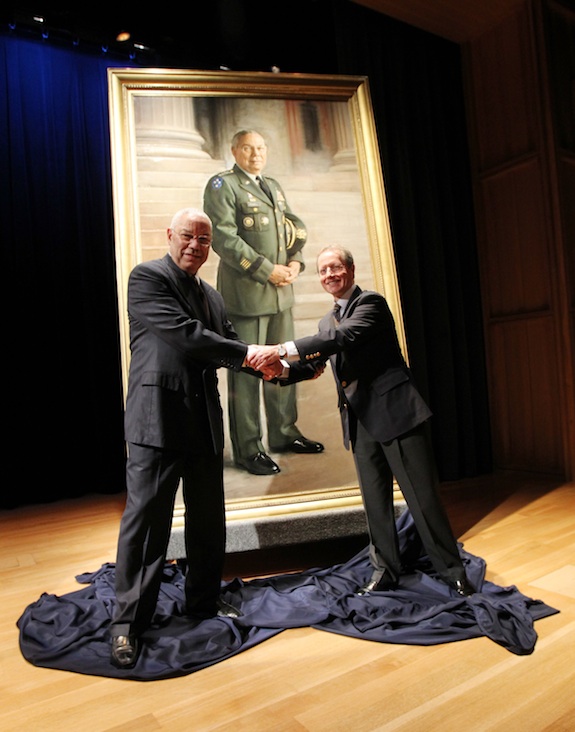The General is in the House; Colin Powell’s Portrait Goes on View
The gallery commissioned a portrait of the first African American Secretary of State and Chairman of the Joint Chiefs of Staff

Gen. Colin Powell discusses his life and career at the unveiling of his portrait at the National Portrait Gallery. Paul Morigi /AP Images for National Portrait Gallery
Colin Powell could be remembered for a number of things. He served under four different presidents and rose to the level of Secretary of State (2001-2005)—the first African American to do so. And still stands as the only African American to be the Chairman of the Joint Chiefs of Staff (1989-1993). He will certainly be remembered for his role in the second Gulf War and his calls for international cooperation, rather than unilateral action. But in the halls of the National Portrait Gallery, he will be remembered as a General.
In a newly unveiled portrait by artist Ron Sherr, whose painting of George H. W. Bush hangs in the museum’s Hall of Presidents, Powell is shown larger than life standing in front of the steps of the Theodore Roosevelt Hall at the National War College at Fort McNair. The gallery first reached out to Sherr in early 2010. Based in Hong Kong, Sherr remembered reading the e-mail, saying he didn’t even have to finish it to know he was interested.
“This is a man who has crossed barriers and has a universal appeal,” says Sherr.

Gen. Colin Powell with artist Ronald Sherr after the unveiling of his portrait. Paul Morigi /AP Images for National Portrait Gallery
But when Sherr looked around at other portraits of Powell, he says, “There were very few that actually captured his likeness.” With a moderate reputation and a formal demeanor, Powell also has a warmth many miss in representations of him. His only request of Sherr was that the portrait actually look like him.
But Sherr’s ambitions were a bit grander. “I thought to myself, this is a picture that has to represent a man in a very powerful position.” Through Powell’s arrangements, Sherr visited several sites including the Pentagon, the National Defense University and Fort McNair. After meeting with Powell in his office in Alexandria, Virginia, Sherr says he started sketching him in front of columns and decided on the location at the National War College.
Though the final portrait presents Powell as one in the same with his official uniform, the recreation of a General who has been retired for nearly two decades was a bit of a challenge.
“He showed up at his office the first day, he drove to the office in his uniform,” remembers Sherr. And the first thing Sherr saw was an arm pop around the doorway with its sleeve hitting well above the wrist. “He had not put the uniform on for 17 years,” says Sherr.
He showed up with Italian loafers but Sherr wanted the original army-issued shoes. “When he finally stood up in them, the soles and heels just crushed down.” The shoes were so worn that, “by the minute they disintegrated more.” Powell had to ask for a new pair.

Gen. Colin Powell poses for a photo with his portrait. Paul Morigi /AP Images for National Portrait Gallery
After sitting with Powell for several sessions, Sherr returned to his New York studio with sketches and photographs. What followed was a long process of adjustment and change so nightmarishly difficult that Sherr says there was a point he thought he wouldn’t be able to complete the work. Turns out, Sherr struggled to capture the General’s likeness as well. But after a long struggle of repositioning limbs and buildings, the portrait was once again on track. “Once I caught his expression the way I remembered in his office, then everything fell into place,” says Sherr.
The expression is one of cool confidence. His hands clasped low in front of him and his body turned slightly away from the viewer, Powell is constructed like a fortress. But slight gestures return the warmth Sherr notes of his sitter. His hat, for example, would traditionally be worn while outdoors, but is instead tucked away by his arm. The portraitist says the expression is the one he saw again and again, each time that he asked a question of Powell.
Even when Powell finally saw the completed portrait, he remained reserved according to Sherr, taking in the comments of those around him. Unveiled for the first time for Powell and the gallery on Sunday, the portrait went on view Monday morning, December 3, 2012.
/https://tf-cmsv2-smithsonianmag-media.s3.amazonaws.com/accounts/headshot/Leah-Binkovitz-240.jpg)
/https://tf-cmsv2-smithsonianmag-media.s3.amazonaws.com/accounts/headshot/Leah-Binkovitz-240.jpg)